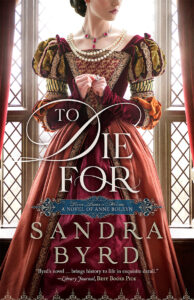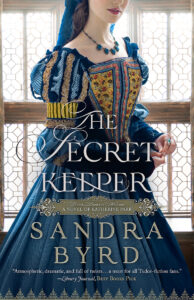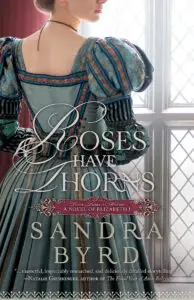 Today, 7th February 2023, historical novelist Sandra Byrd has relaunched her Tudor Ladies in Waiting series, a wonderful series of Tudor-themed novels.
Today, 7th February 2023, historical novelist Sandra Byrd has relaunched her Tudor Ladies in Waiting series, a wonderful series of Tudor-themed novels.
The series consists of To Die For: A Novel of Anne Boleyn, The Secret Keeper: A Novel of Katherine Parr, and Roses Have Thorns: A Novel of Elizabeth I. They’re all excellent reads.
To celebrate, we have an interview with Sandra.
Over to Sandra…
What about the Tudor era made you want to write about it?
 The most engaging stories take place during extraordinary times. Because the stakes were so high during the Tudor years, there was always excitement and change. Love, lust, hatred, murder, good versus evil, self-sacrifice, gluttony and greed, envy, spiritual birth or renewal, spiritual deception, friendship and betrayal, a family that remains true, and family who backstabs you out of selfishness—these are all elements which make for exciting reads. The Tudor Court had them in abundance. They underwent everything we undergo today, too, only writ large, with bigger stakes than most of us. So we both identify with them and are, maybe, a little in awe too.
The most engaging stories take place during extraordinary times. Because the stakes were so high during the Tudor years, there was always excitement and change. Love, lust, hatred, murder, good versus evil, self-sacrifice, gluttony and greed, envy, spiritual birth or renewal, spiritual deception, friendship and betrayal, a family that remains true, and family who backstabs you out of selfishness—these are all elements which make for exciting reads. The Tudor Court had them in abundance. They underwent everything we undergo today, too, only writ large, with bigger stakes than most of us. So we both identify with them and are, maybe, a little in awe too.
Amazing gowns, massive castles, stately homes, and precious jewelry don’t hurt to write and read about, either! The period is enchanting on all levels.
What was the inspiration to write these novels? What influenced you to write about these women from the point of view of their ladies in waiting?
My love of all things Tudor began as a young teen when I binge-read the Jean Plaidy/Victoria Holt/Philippa Carr books, many of which remain on a shelf of honor. Although I later went on to read much nonfiction before and after researching for this series, the fiction brought the characters to life in my mind and heart – where they remain. I wanted to add books for Tudor fiction fans because I know most of us are always looking for more to read about them.
I chose to write from the point of view of the Queens’ ladies in waiting because a friend sees things a bit more objectively than we might see ourselves. A friend sees our good and bad moments and loves us anyway; it’s more objective than telling the story about yourself. Also, sharing the story from the position of a friend gives access that, for example, showing from the position of a servant would not allow. I think choosing the story’s point of view depends on what you want to put across. In this series, I’m seeking insight into the queens’ hearts.
How do you create fictional characters?
 There was very little written by women in that era, in their own voices and about their own lives. Katherine Parr was famously the first woman to publish under her own name in England, so female voices began to be heard. I drew from what we know about the women, factually, what we know about women of the era, the snippets that exist of what they actually said, and then blended them with the desires of most women across time.
There was very little written by women in that era, in their own voices and about their own lives. Katherine Parr was famously the first woman to publish under her own name in England, so female voices began to be heard. I drew from what we know about the women, factually, what we know about women of the era, the snippets that exist of what they actually said, and then blended them with the desires of most women across time.
Even though the times were different, people are much the same then and now. We want happiness, love, satisfaction, security, friendship, opportunities for our children, and a chance to advance our causes. Of course, fiction will always take some liberties because it’s not a transcript – even if one existed. But an honorable historical novelist will do what she can to stay mostly faithful to the times.
Can you imagine any of your historical characters in different times?
Oh yes. As I said above, the desires women have mainly haven’t changed, I don’t think. One of my favorite sites to follow is Royalty Now, wherein the amazing Becca Saladin Segovia reimagines the wives of Henry VIII as modern women. If you haven’t visited her site, you should! History Now Studios
What was a surprising moment of discovery or experience in your research?
In 1566 along came Helena von Snakenborg.
How had I missed her in a lifetime of reading the Tudors? I stumbled across Helena’s tale while writing the second book in this series, focusing on Katherine Parr. I have had to infer some into the friendship between Helena and Elizabeth, but I did try to keep all known facts. The queen intervened unusually with another monarch to allow Helena to remain in England, and Helena experienced both the highs and the lows of being one of the queen’s favorites.
 For Queen Elizabeth I, I’d been hoping all along to tell the story of a real lady in waiting, but one whose story had not been often told. So I was grateful to uncover Helena. The fact that she served Elizabeth I for so long and closely made her an excellent point-of-view character.
For Queen Elizabeth I, I’d been hoping all along to tell the story of a real lady in waiting, but one whose story had not been often told. So I was grateful to uncover Helena. The fact that she served Elizabeth I for so long and closely made her an excellent point-of-view character.
What sort of “hidden gems” have you discovered in researching this era that people may not know?
For all the years I studied the Tudors, I had not realized that most of their gowns were pieces that were pinned together. This was economical because they were so fantastically expensive. Once a girtle wore out, you could still use the matching sleeves. I used this tidbit in a plot element. I try to do that with many of my “novel” discoveries during research.
Where do you draw the line between fiction and fact while creating your characters and story?
While this is a work of historical fiction, I’ve sought to remain as true to history as to fiction.
 I’m a lifelong Tudorphile and enthusiast who has done extensive research, and I hew closely to the vast majority of known history. However, I am primarily a novelist – the noun is “novel,” and the modifier is “historical” in a historical novel, so there are places where fiction enters the story to be true to that dramatic art form. When fictionalizing, I focus on plausibility for the era and draw my conclusions and insights from it as I shape the story to fit fiction’s structure. Writing historical fiction gives me a bit more latitude than nonfiction.
I’m a lifelong Tudorphile and enthusiast who has done extensive research, and I hew closely to the vast majority of known history. However, I am primarily a novelist – the noun is “novel,” and the modifier is “historical” in a historical novel, so there are places where fiction enters the story to be true to that dramatic art form. When fictionalizing, I focus on plausibility for the era and draw my conclusions and insights from it as I shape the story to fit fiction’s structure. Writing historical fiction gives me a bit more latitude than nonfiction.
Please purchase my Tudor Ladies in Waiting Series here: https://tinyurl.com/TudorLadiesinWaiting The books are available in print, eBooks, and to borrow on Kindle Unlimited. Earlier versions of these books were available in 2011, 2012, and 2013.
Please visit my website to review many Tudor blogposts: https://www.sandrabyrd.com/blog